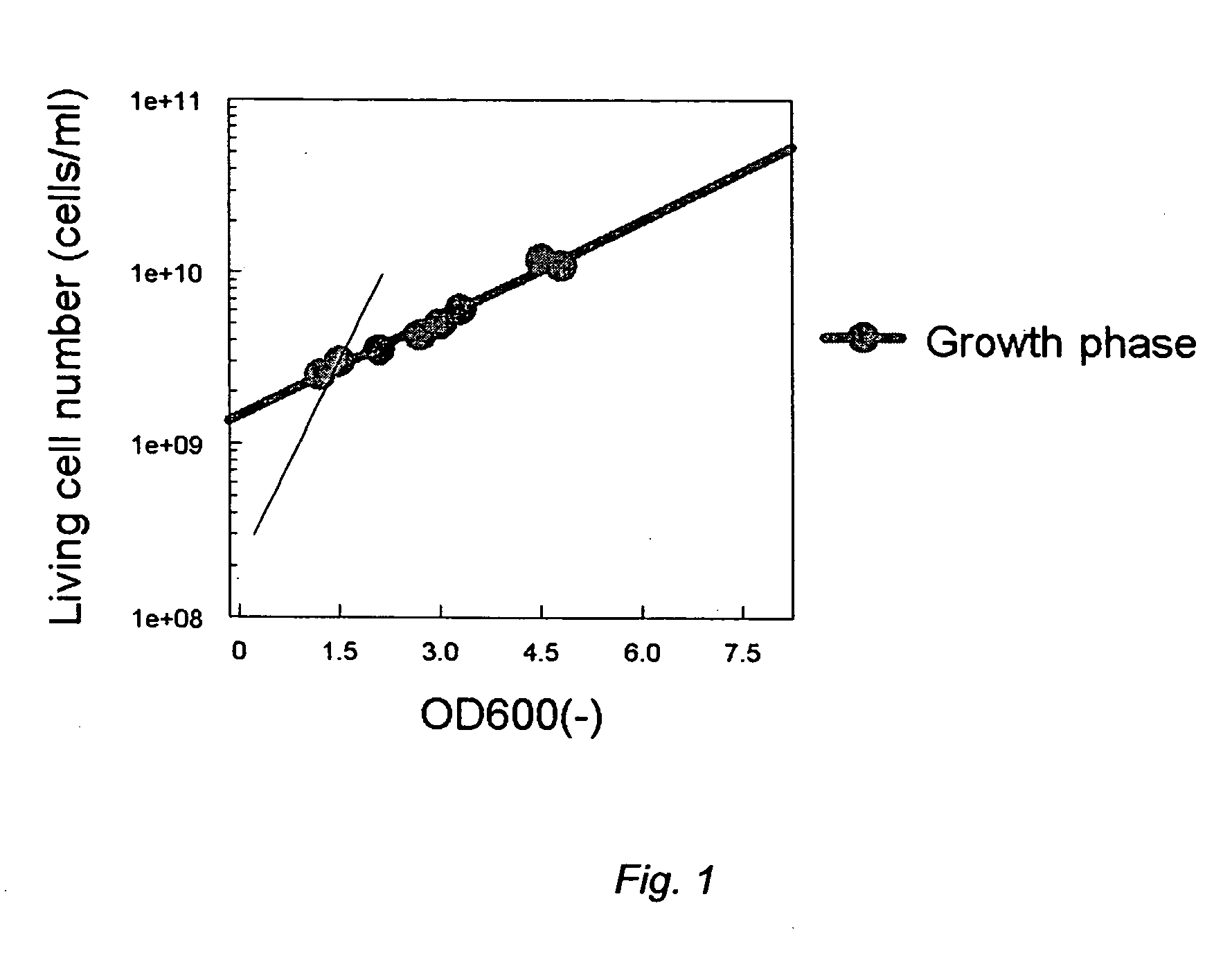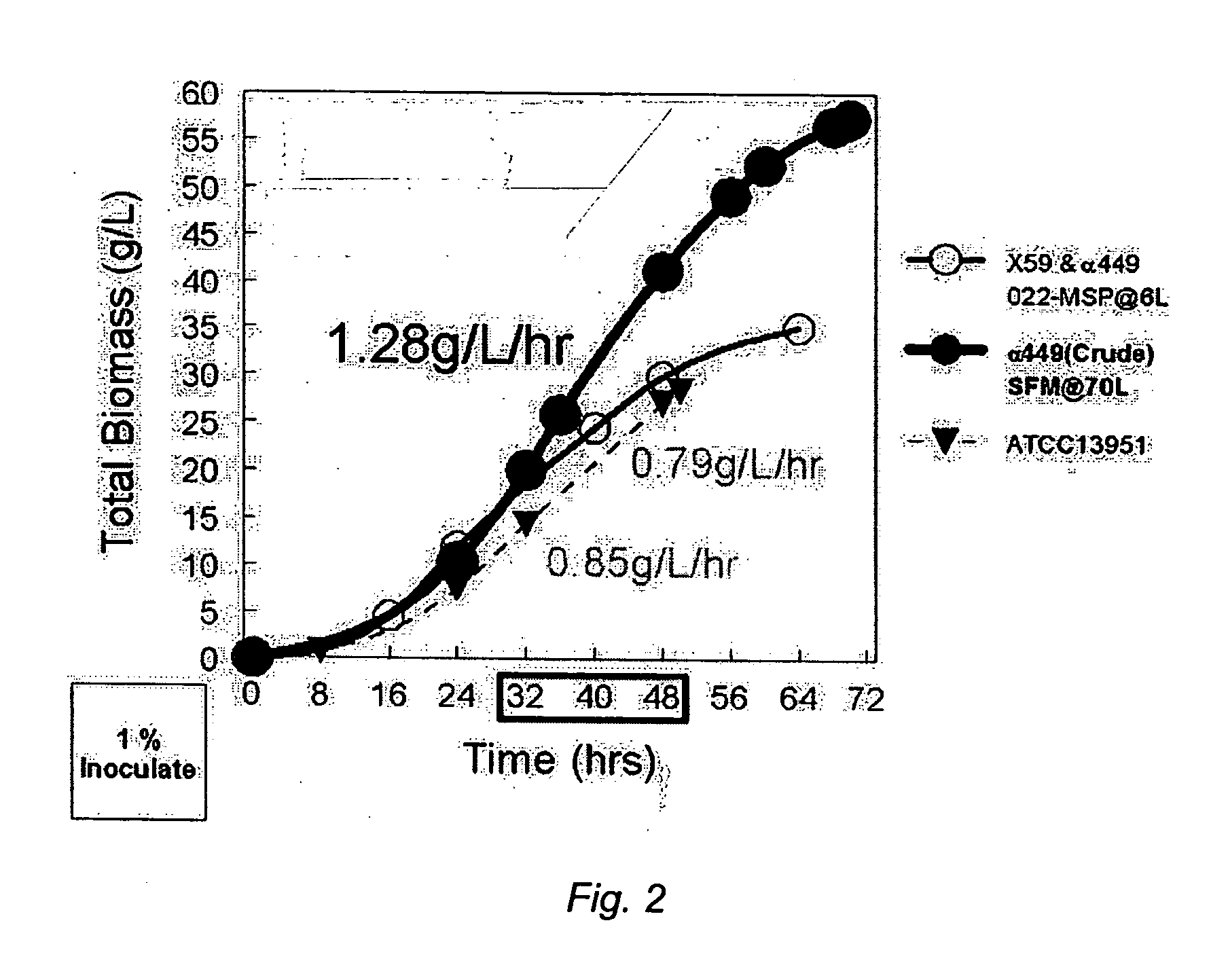Compositions and methods of using a regulator of biopolymer production
- Summary
- Abstract
- Description
- Claims
- Application Information
AI Technical Summary
Benefits of technology
Problems solved by technology
Method used
Image
Examples
example 1
PREPARATION OF WHITE, HIGH GLUCOSE RESISTANT SPHINGOMONAS
[0065]Sphingomonas X287 (ATCC PTA-3487) was used to inoculate 50 ml ¼YM−, having either 1% or 5% glucose in 125 ml baffled flask at 30° C. for two weeks without shaking. No exopolysaccharide-negative mutants appeared when the culture was spread onto a ¼YM+ plate after such an extended incubation. The same culture was spread onto a plate of ¼YM having 10% Glucose. Isolated colonies (83) were selected and used to inoculate 2 ml ¼YM having 3% Glucose, and then incubated for 40 hrs at 30° C. with shaking at 300 rpm. These cultures were spread on high glucose plates, and 12 colonies chosen and saved as X729-X741. Six out of those twelve mutants were visually white mutants.
[0066] Colonies were used to inoculate 2 ml YM− in small tubes and shaken at 300 rpm for 24 hrs at 30° C. (referred to as seed-1). Then 100 μl of these cultures were used to inoculate 5 ml B10G3, which culture was placed at an angle and incubated at 300 rpm for ...
example 2
IDENTIFICATION OF SPHINGOMONAS NO LONGER RESPONSIVE TO SPSN
[0075] This example describes identification of a DNA sequence that suppresses biosynthesis of sphingan and xanthan by the following steps: (1) making an expression library of Sphingomonas S-88 genomic DNA; (2) transforming the expression library into Sphingomonas S-7; and (3) screening for suppression of exopolysaccharide S-7 production in Sphingomonas S-7 (i.e., spread bacterial cultures on plates and observe colonies for non-mucoid appearance). Primers SEQ ID NO:5 (22mer), and SEQ ID NOS:6 and 7 (26 and 27mer, respectively) were made and used with template Z964 (pBluescriptKS-BH, 716 bp, which is a fragment from Z939 (pRK311-s88nc2, 2.7 Kb)) to produce a 573 base pair fragment (SEQ ID NO:1) encoding, inter alia, functional spsN. The 573 base pair PCR fragment (SEQ ID NO:1) was cloned into plasmid pRK311, and two independent clones (X026 and X029) were further tested as follows:
StrainPlasmidS-7S-88NW11S-130S-194S-198NW1...
example 3
COMPARISON OF EXOPOLYSACCHARIDE PRODUCTIONS BETWEEN A SPHINGOMONAS STRAIN NO LONGER RESPONSIVE TO SPSN AND ITS PARENT STRAINS
[0081] The original slime strain X287 and α016 were compared with mutant α062 under several 42 L fermentation tests. 400 ml 24 hrs flask culture was prepared as 1% starting culture broth for those experiments. The strain ATCC31464, parent of X287, was used a capsule forming gellan wild type strain.
[0082] 42 L / 70 L-Fermentation Test (40 g / L Glucose)
24 hrs48 hrs60 hrsX28711.0 g / L-7980 cp21.8 g / L-16,000 cp(G116)α016) 9.6 g / L-5040 cp19.2 g / L-10,400 cp20.7 g / L-11,900 cp(G118)α06223.2 g / L-13,500 cp(G120)α06210.3 g / L-6650 cp22.8 g / L-13,100 cp(G131)
[0083] 42 L / 70 L-Fermentation Test (45*-50 g / L Glucose)
24 hrs48 hrs60 hrs72 hrsα062(G121)6.6 g / L-4160 cp21.6 g / L-12,300 cp26.1 g / L-18,000 cpα062(G123)8.8 g / L-5210 cp21.7 g / L-15,800 cp25.5 g / L-24,700 cpα062(G131)6.9 g / L-3910 cp23.2 g / L-12,800 cp25.7 g / L-16,200 cp
[0084] The broth was precipitated by 2 volumes IPA and su...
PUM
| Property | Measurement | Unit |
|---|---|---|
| Temperature | aaaaa | aaaaa |
| Temperature | aaaaa | aaaaa |
| Fraction | aaaaa | aaaaa |
Abstract
Description
Claims
Application Information
 Login to View More
Login to View More - R&D
- Intellectual Property
- Life Sciences
- Materials
- Tech Scout
- Unparalleled Data Quality
- Higher Quality Content
- 60% Fewer Hallucinations
Browse by: Latest US Patents, China's latest patents, Technical Efficacy Thesaurus, Application Domain, Technology Topic, Popular Technical Reports.
© 2025 PatSnap. All rights reserved.Legal|Privacy policy|Modern Slavery Act Transparency Statement|Sitemap|About US| Contact US: help@patsnap.com



